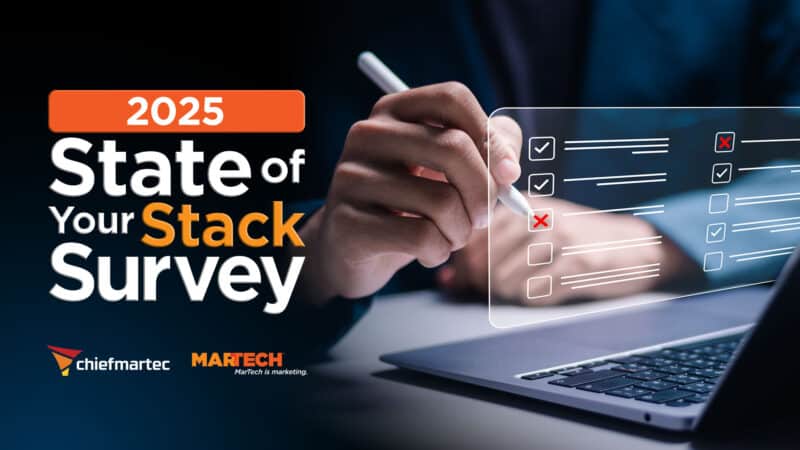
Practical discussions about marketing technology sometimes boil down to this: “How can we collect this data on our customers without them knowing about it?”
That doesn’t strike me as the best way to treat people, but the alternatives are scary — either not collecting the data, or letting people know what we’re doing. Egads. They’ll freak out, won’t they?
More on that later, but please walk with me through a thought experiment.
What if we took the bold step of being completely transparent about the data we collect? What would that look like? I’m not saying it’s possible, or even that it’s the right solution, but let’s think about it.
The problem with privacy
Customers are confused and feel a lack of control
In 2019, and again in 2023, Pew Research found that Americans are concerned, confused and upset about how their data is being collected. While much of their ire is directed toward social media companies and the government, only one in five “are confident that those who have their personal information will treat it responsibly.”
There’s a temptation in the martech space to shrug off those concerns. “They’ll get over it.” Or, perhaps, “We’re not as bad as or no worse than the other guy.”
If we told customers how much data we actually collect on them, they would probably be angry, feel betrayed and lose some trust in us. We can put off that day of reckoning, but the problem is only going to accumulate, and when the truth finally comes out — as it will — the anger and sense of betrayal will be even worse.
How long would that initial, shocked reaction last? Would it result in disgust and rejection, or might it morph into a feeling of relief that someone was finally straight with them?
Dig deeper: U.S. state data privacy laws: What you need to know
What people say about privacy vs. what they do
I don’t want to overstate my case. Every good marketer knows that what someone says is not a good measure of what they will do. When we watch the actual behavior of consumers, they continue to use websites even when they know their data is being hoovered up by half the world. Many consumers simply admit defeat and say privacy is a thing of the past. A Deloitte article from 2021 makes this point well.
Still… Just because people are willing to put up with something doesn’t mean they like it, and it certainly doesn’t mean they wouldn’t prefer something else. Is there another option?
What would it be like to collect data with full knowledge and consent?
Let’s imagine a company that decided to go the other way. It only wanted to collect information with the full knowledge and consent of its customers. How would they do that?
Privacy by design
Most of the time, systems are built for the needs of companies, then privacy concerns are reluctantly and somewhat awkwardly bolted on after the fact — often with reluctance and a sense of “How much of this do we really have to have?”
What if privacy was the default setting, rather than something you had to opt into? What if consumers could see how their data was being collected and used? What if the bargain was explicit?
The ‘free’ internet
The “sneaky data collection regime” we live in today is a consequence of the way the internet was envisioned and built from the beginning — on the assumption that it should be free. I remember those days. There was a prevailing attitude that “information wants to be free” and that everyone had a right to be anonymous.
Ads are the most convenient way to fund such a system, so advertising technology ruled the web. Data geeks rose to prominence and advertising technology got increasingly invasive as companies found more ways to monetize consumer information.
Now, everyone assumes that the internet should be free. Consumers often think they should get email, chat, video and all sorts of services “for free” — without thinking too much about what that means. Most people seem to believe the price they pay for these “free” services is a few annoying ads. They have no idea that ads are only the tip of the iceberg.
The internet isn’t free, we’re just paying for it with different types of currency: Attention, for sure, but also with private details about our lives. The people who collect that information desperately don’t want us to know everything they collect and know about us.
Your ‘free weekend’ at the beach
We don’t have to be sneaky about this. When you go to a timeshare resort for a “free” weekend, you know that you’re paying for it by sitting through the 90-minute sales presentation — which always manages to run three hours.
The point is not that the timeshare industry is an example of moral virtue, but there’s a certain honesty to that transaction. You’re getting a couple days at the resort so they can try to sell you some real estate.
Why can’t we do that with data?
Dig deeper: 3 strategies to navigate change as digital privacy evolves
Consent management
The EU, California and some other jurisdictions are trying to force transparency and data accountability onto reluctant industries. These efforts are essentially comedy and farce because the legislators are completely out of their depth and don’t understand the technology they presume to regulate. We end up with these ridiculous “accept cookies” pop-ups, which comply with the law, but haven’t fixed the problem — which is that consumers should have a right to control how their data is used.
We’ve giving them a choice!
Yes, I can hear the complaints.
“If they actually valued their privacy — if they really cared about this — they’d click the ‘manage cookies’ option and decide how their data is used.”
No. First, most sites don’t have a “manage cookies” option — it’s just accept or don’t — and we’re presenting them a choice that reminds me of something from “The Hitchhiker’s Guide to the Galaxy.”
“All they have to do is file a form in triplicate and present it to the commissioner on the second Tuesday of each month between the hours of 10:00 and 10:20.”
Nobody believes the “accept cookies” regime is reasonable or consumer friendly, and just because it’s technically possible to do something doesn’t mean you’re giving your customers a legitimate choice.
Consumer data is a necessary part of our revenue structure
I understand there are perfectly legitimate reasons to collect consumer data. That doesn’t mean it’s OK to collect that data without people’s consent.
The question behind this lengthy thought experiment is whether it’s possible to reconcile/harmonize the business need for data with the customers’ preferences for security, privacy and autonomy. There’s no way to answer that question right now because not enough businesses have tried it.
Two small steps in the right direction
Life is complicated and chaotic, and nothing so socialized and unstructured as people’s online behavior can be solved by a group of well-meaning experts. The “invisible hand” has a curious backswing. Things need to be tested and proved in the real world — not dreamed up on a white board — and it’s often difficult to predict what will come out on top.
I am not advocating some top-down, bureaucratic or legislative solution. Nevertheless, I believe we need to work toward transparency and trust.
Here are two practical things companies can do to start that process.
Explain yourself
Create a company value that says before you collect any information from a customer, you write an explanation for why what you’re doing is in the customer’s best interests. In some imaginary, ideal world of perfect transparency, you would also publish this value on your website. For now, let’s just work on changing the mindset. The discipline of writing those explanations will nudge things in a better direction.
Work toward fixed terms and conditions
Just as “accept cookies” is nonsense-level consent, “agreeing” to terms and conditions is a farce. Nobody reads them, and few who read them understand them.
There needs to be something like standard terms and conditions for a website. Perhaps there would be a few variations, so that on one site you’re agreeing to the Geneva protocol, and on another you’re agreeing to the Las Vegas protocol. In that world, people could get a general understanding of what the terms and conditions mean. The evening news could explain it. Podcasters and YouTubers could dig into the details. We could develop something like informed consent.
As it stands, where every site has its own custom T&Cs, nobody is informed and nobody really consents.
Conclusion
I don’t want to overplay my hand. I can’t say the current situation is untenable because it seems to be “working,” at least in some sense. But at what cost? It’s breeding a culture of mistrust, the loss of personal privacy and a kind of sneakiness that doesn’t seem healthy.
Is there another way? I hope so, and I believe it’s worth aiming in that direction.
Did deeper: Navigating personalization vs. privacy: 3 tips for delivering win-win customer experiences
The post How to build customer trust through data transparency appeared first on MarTech.





